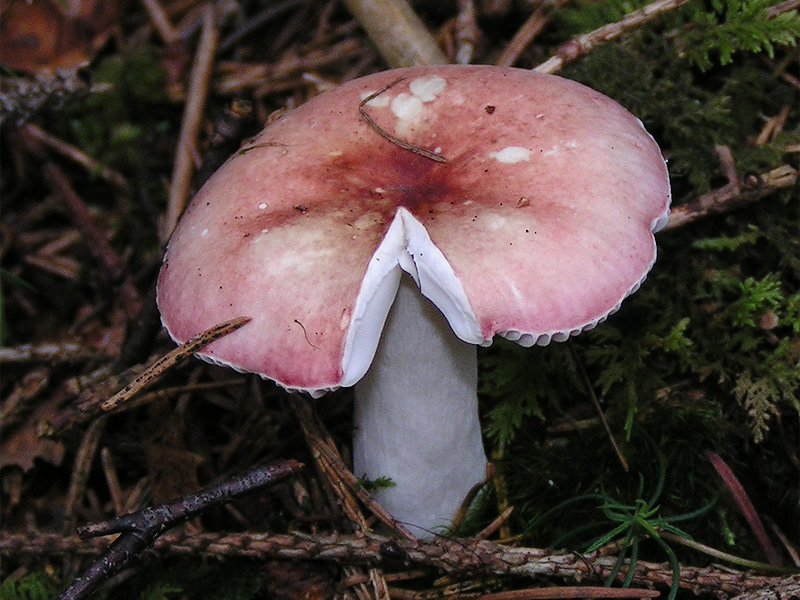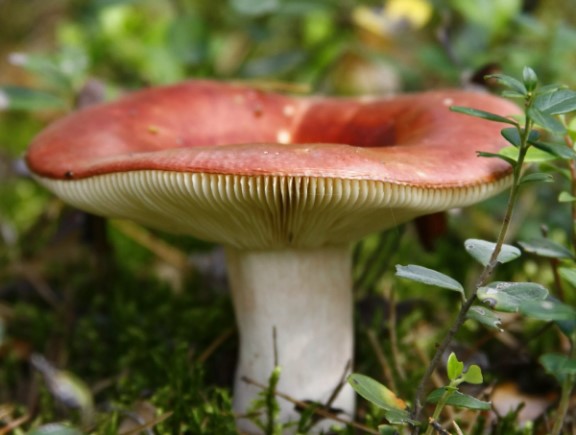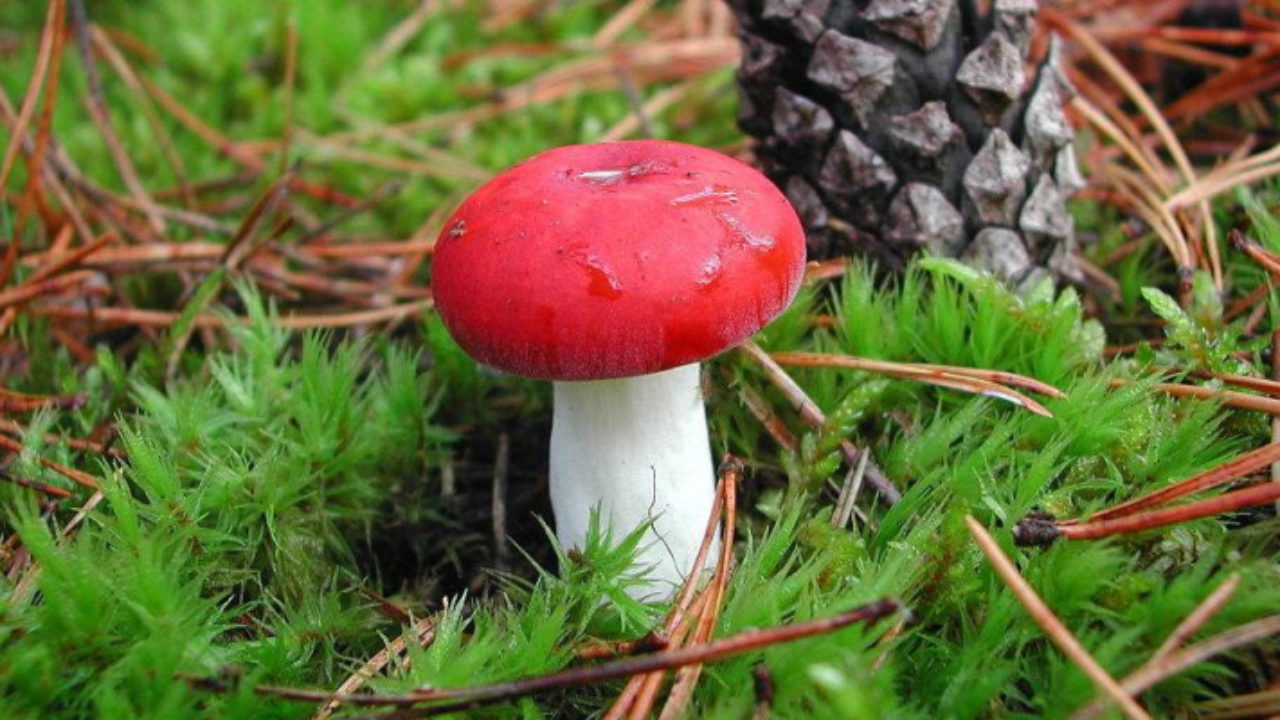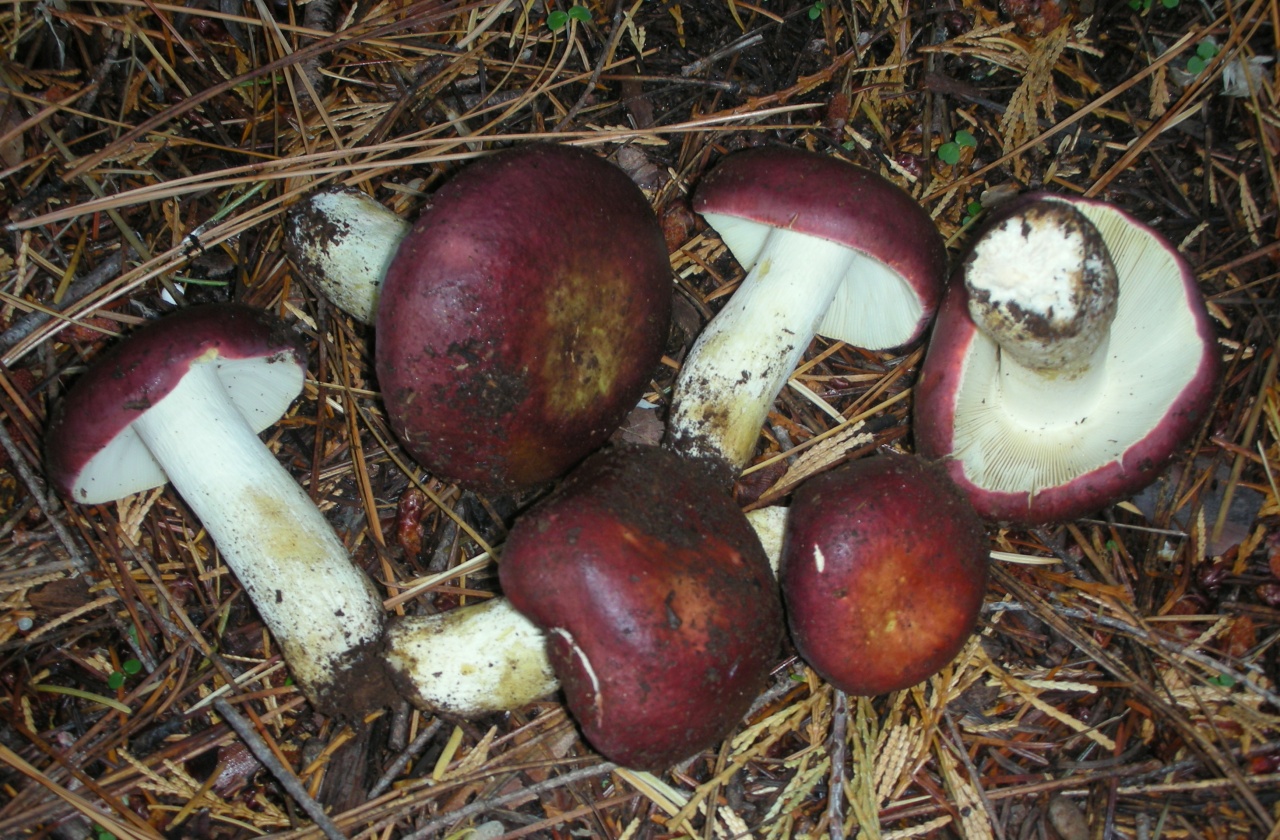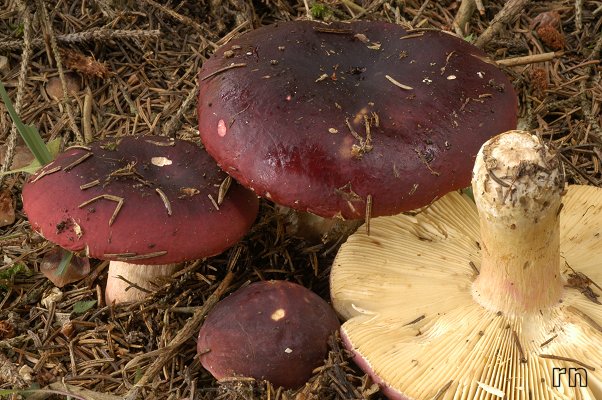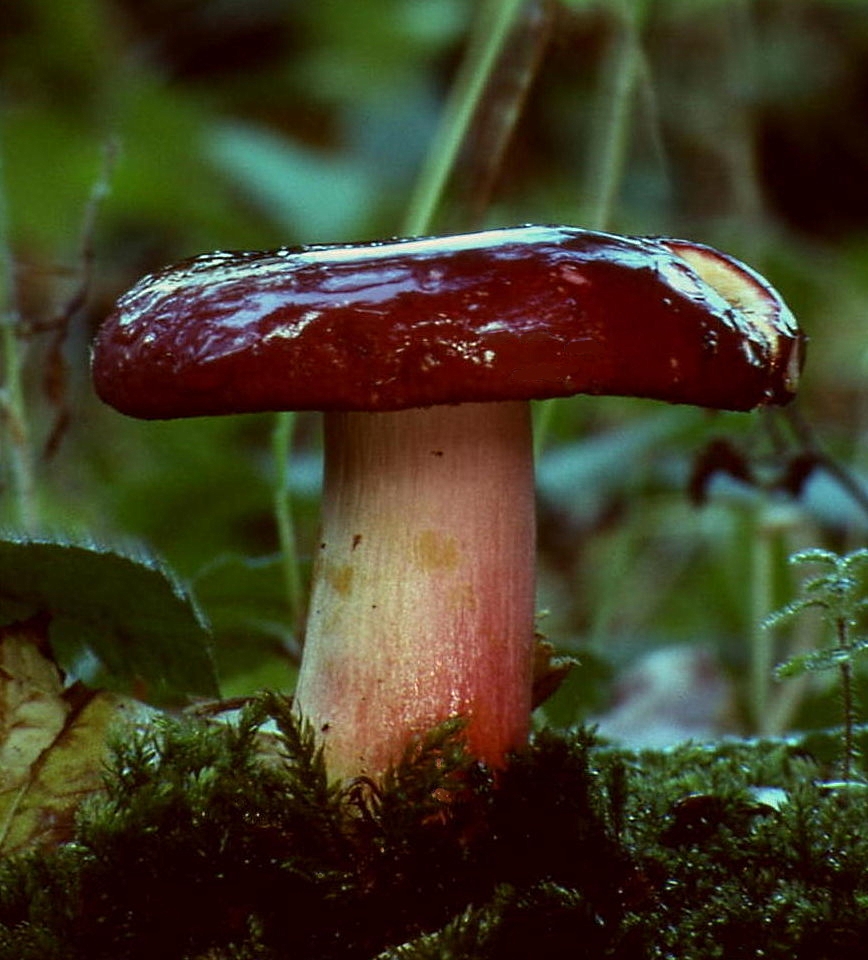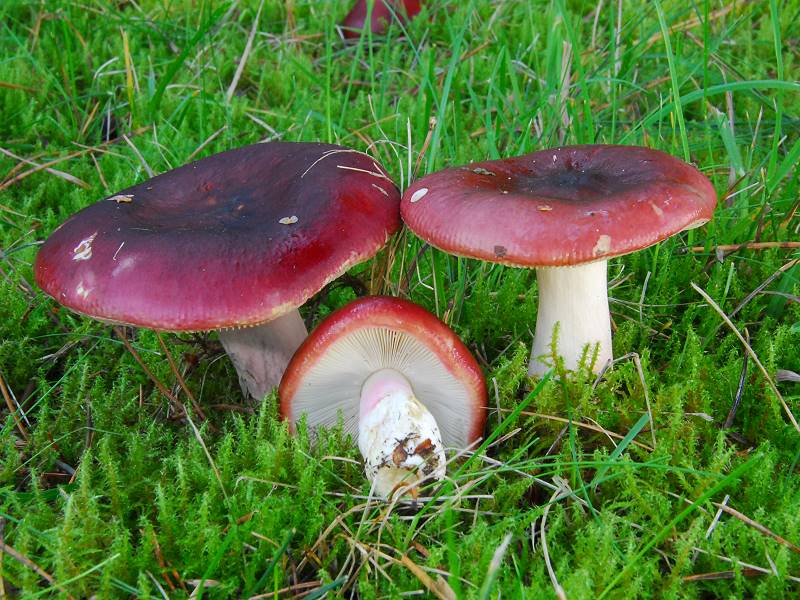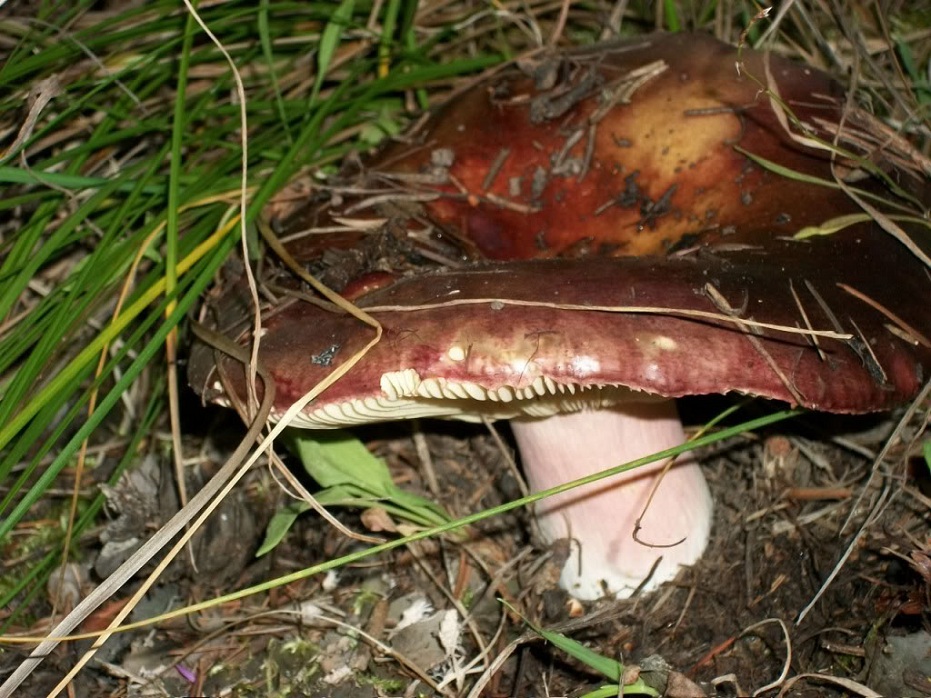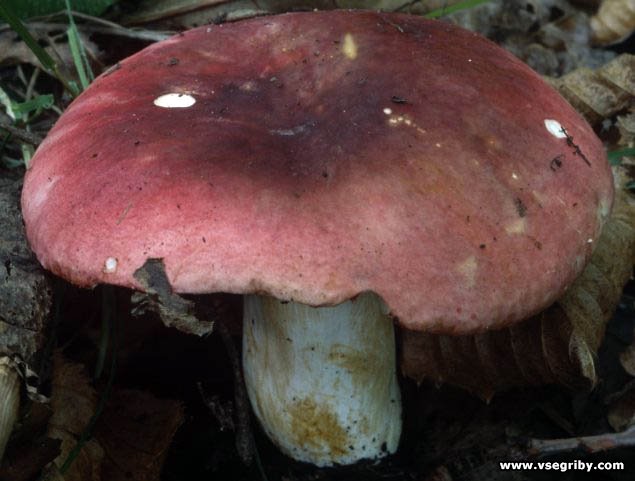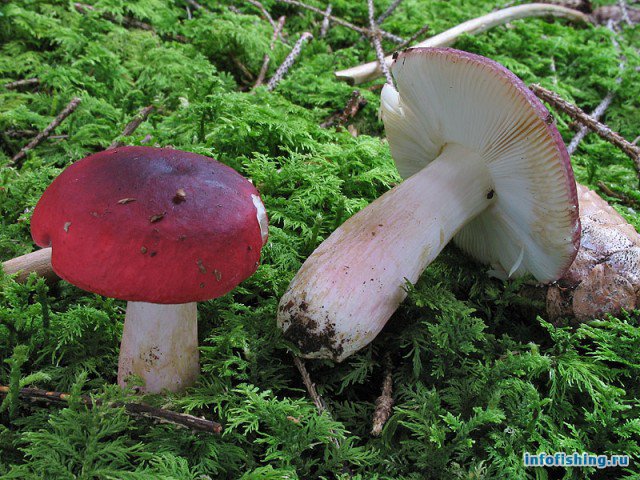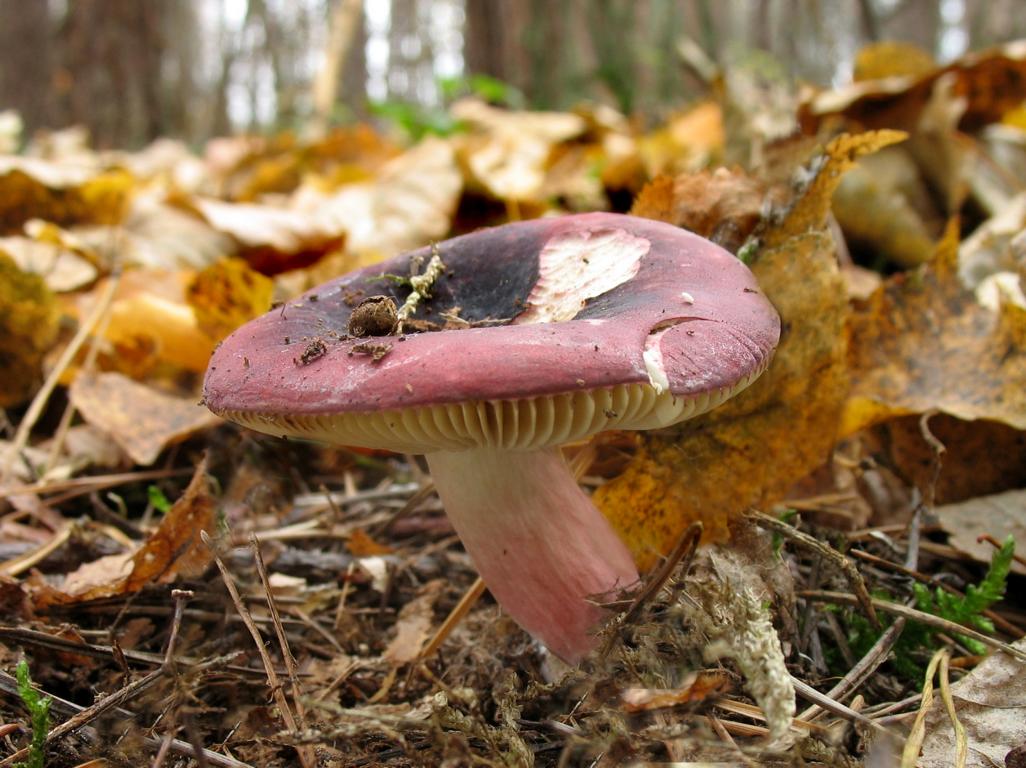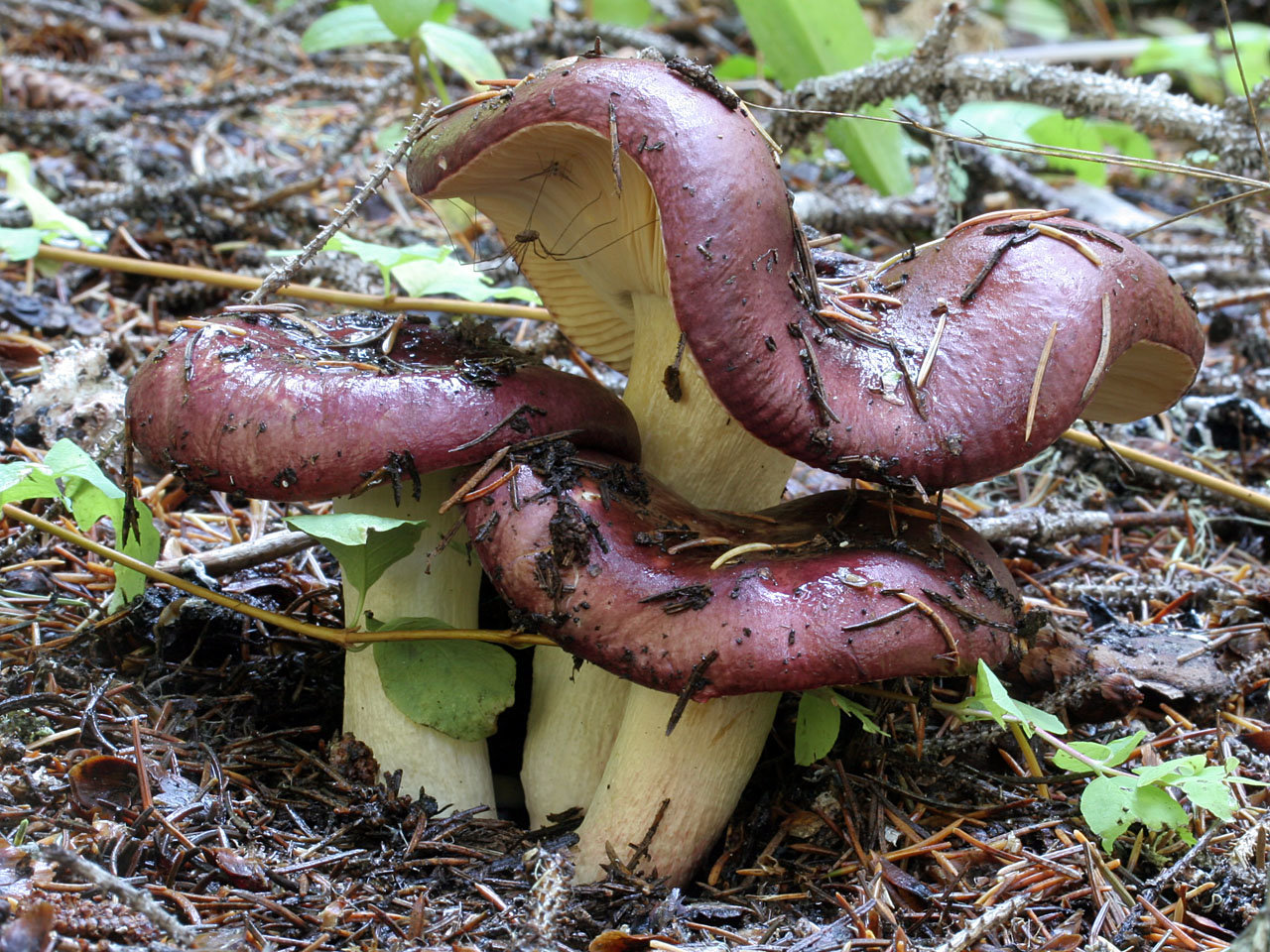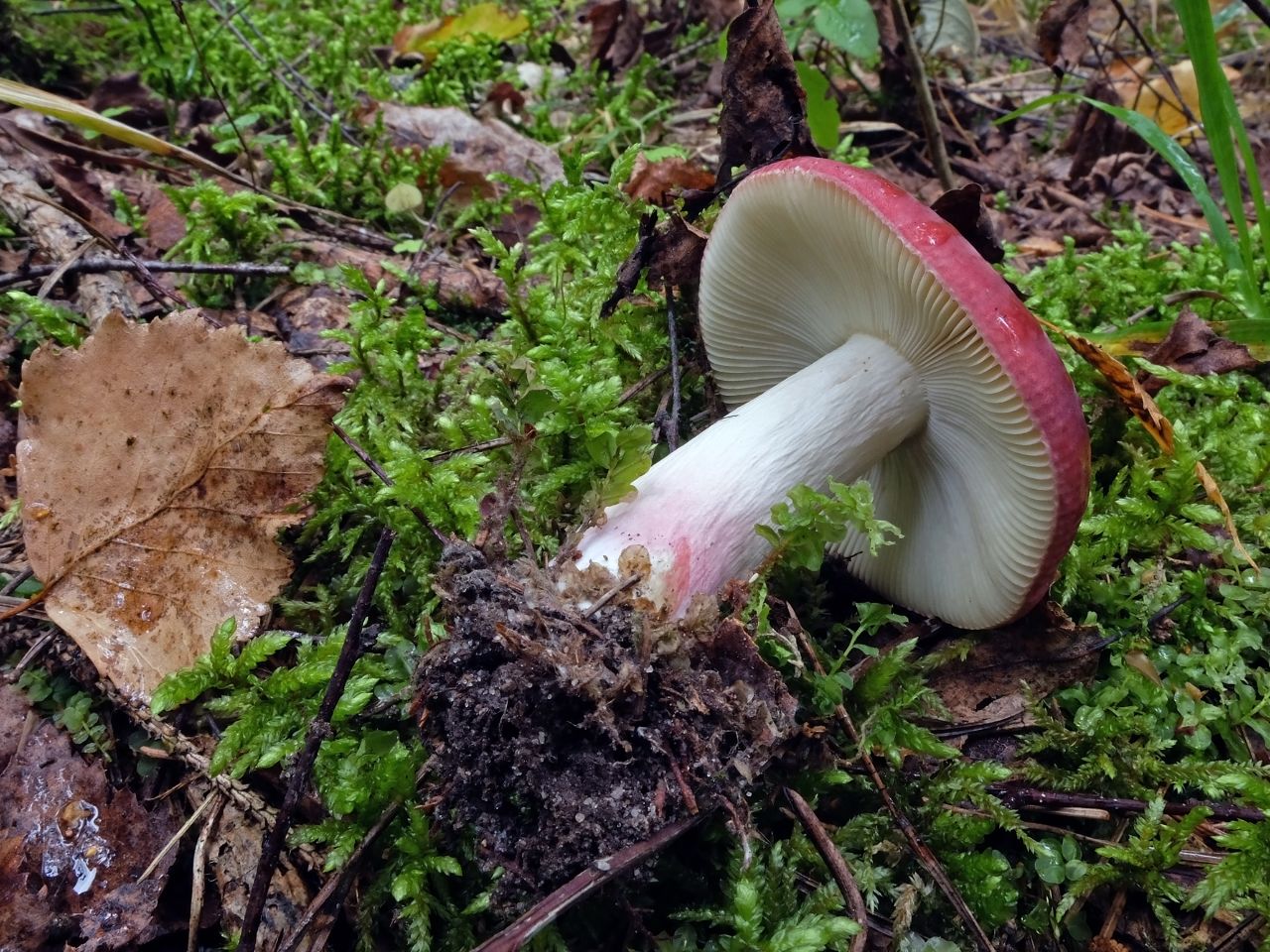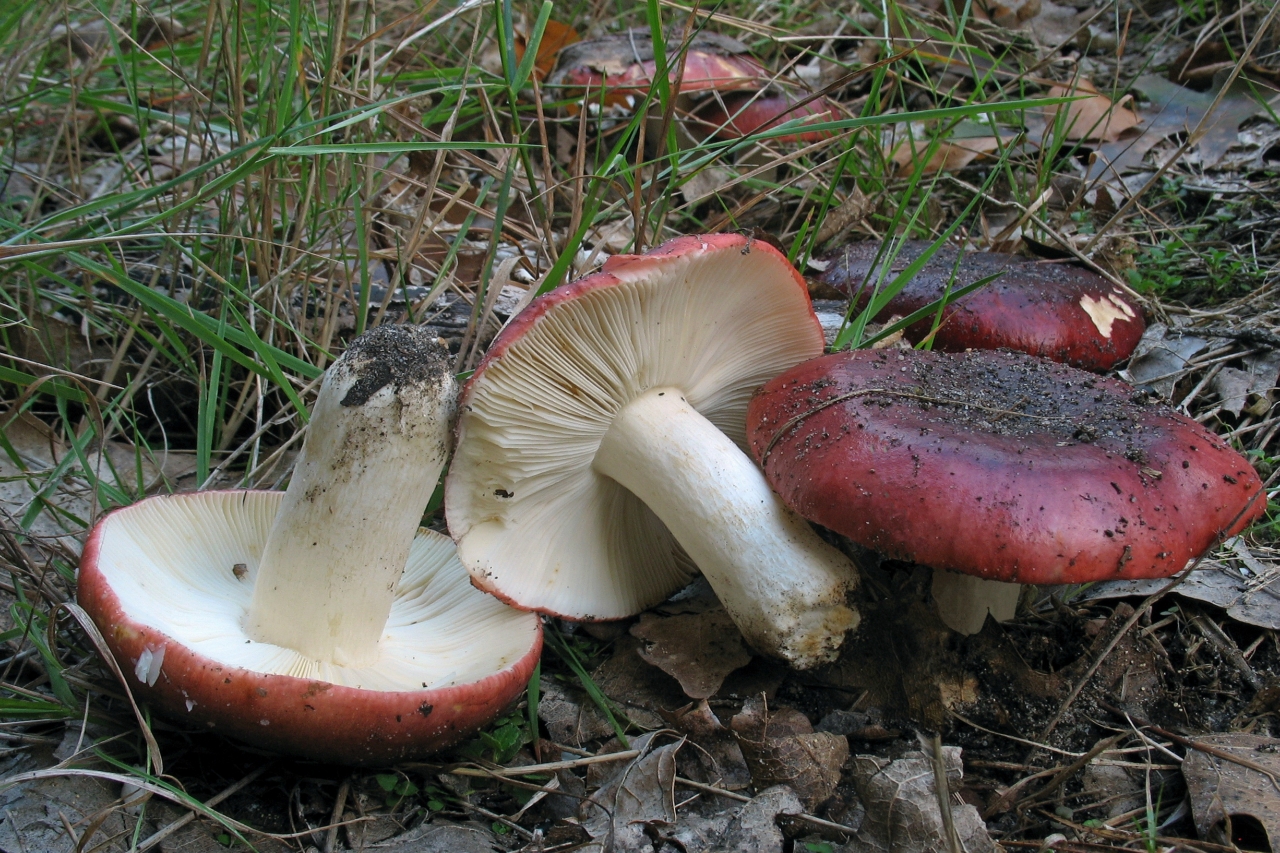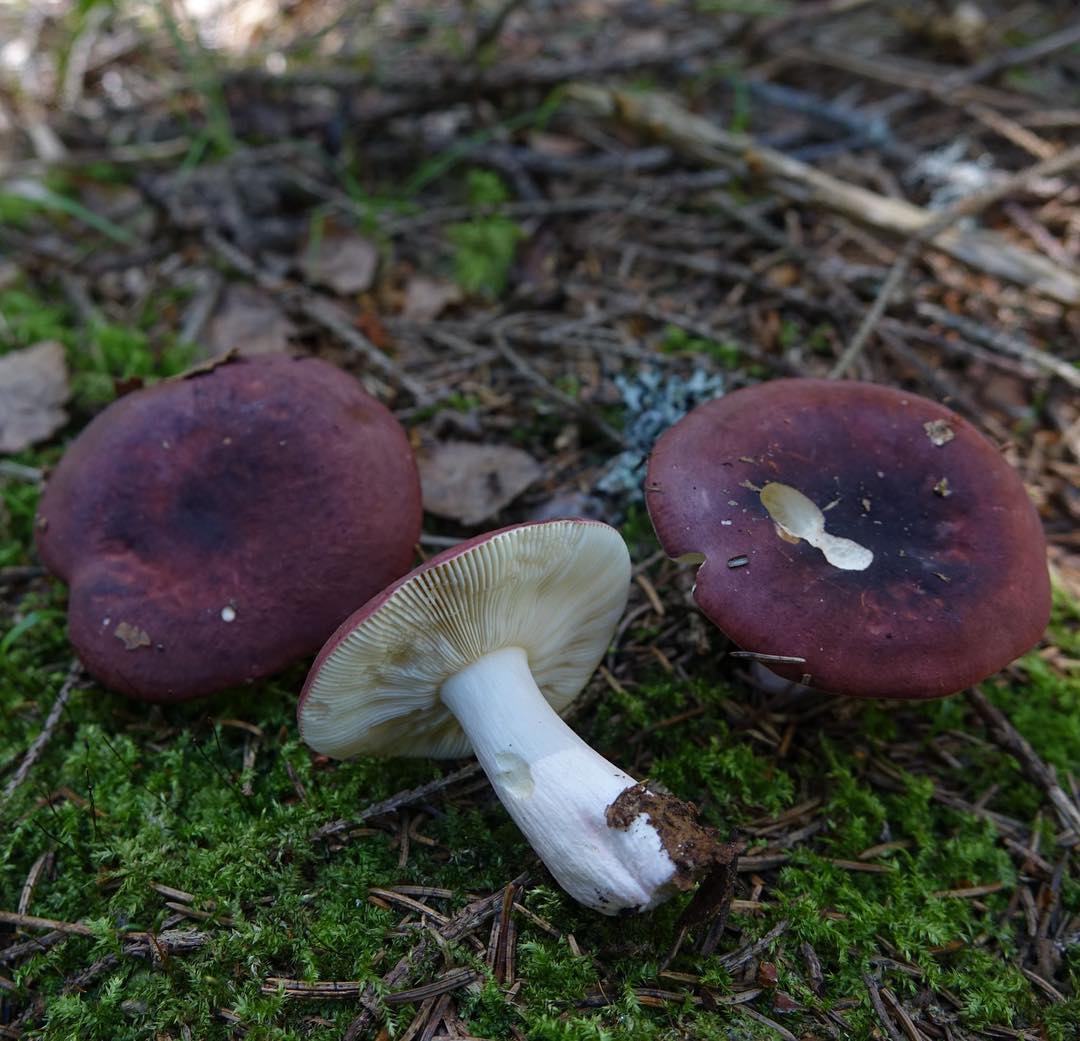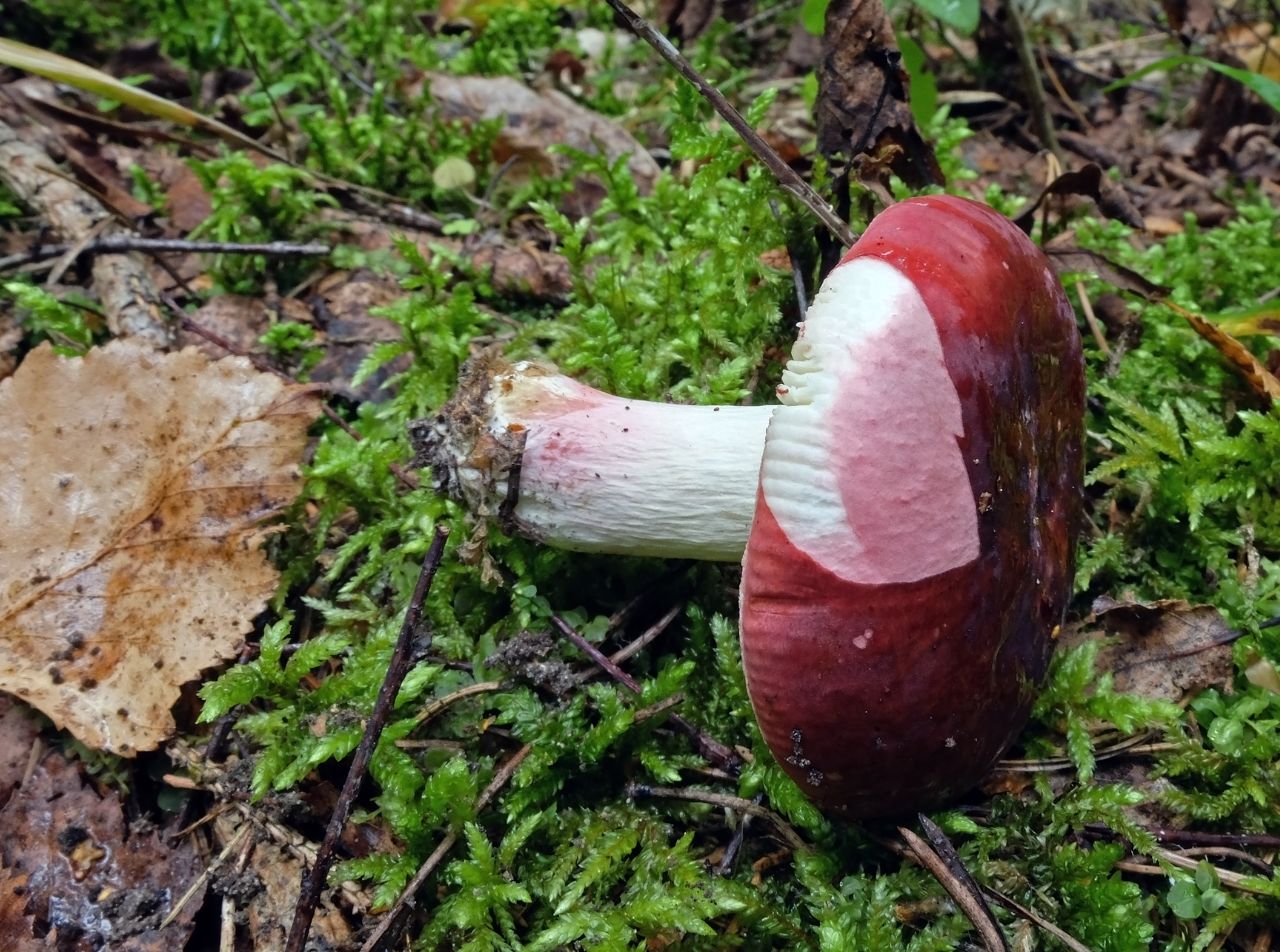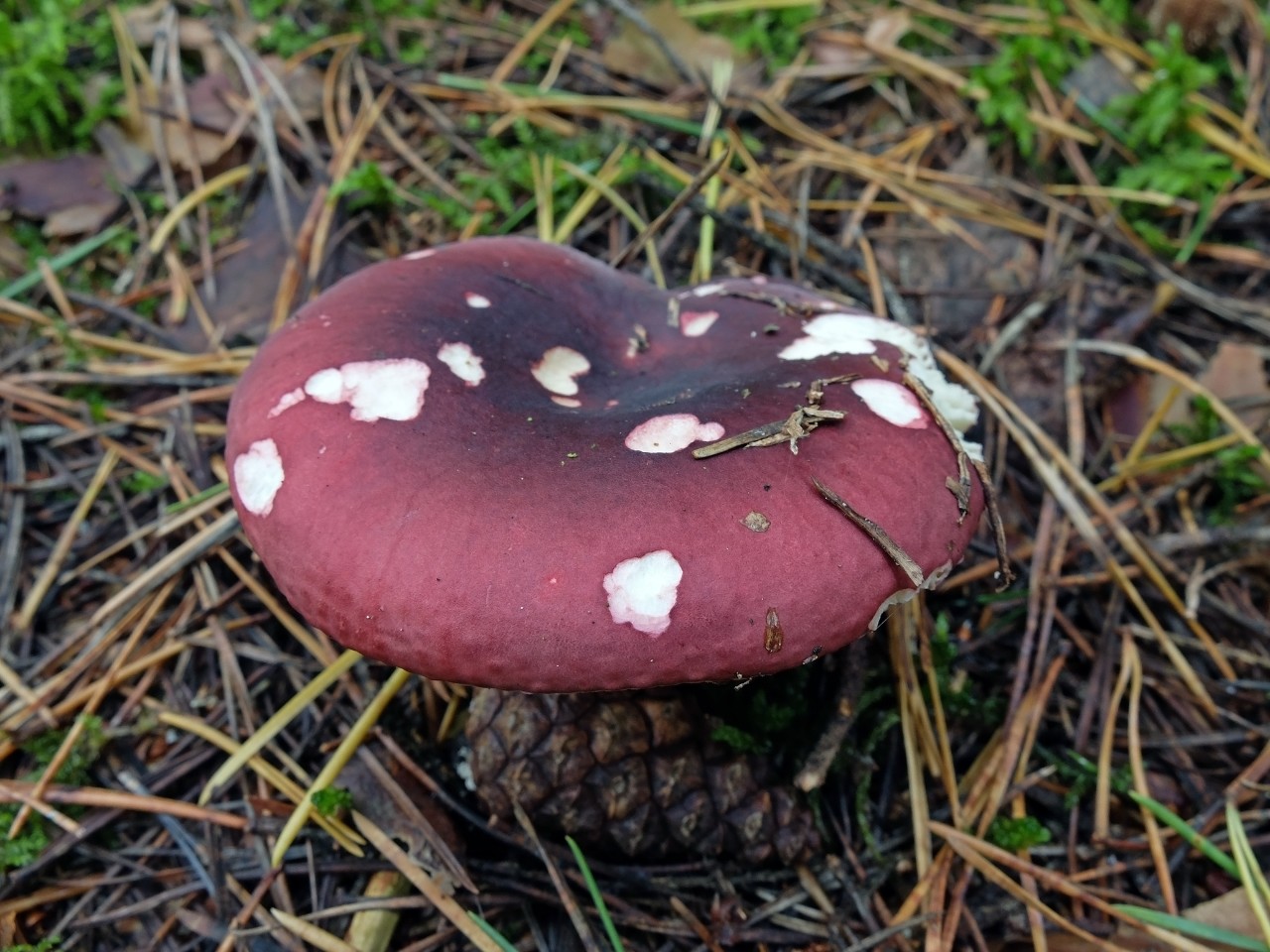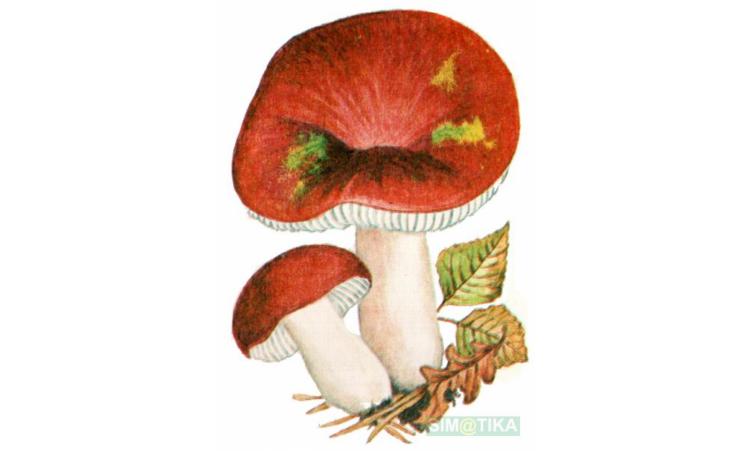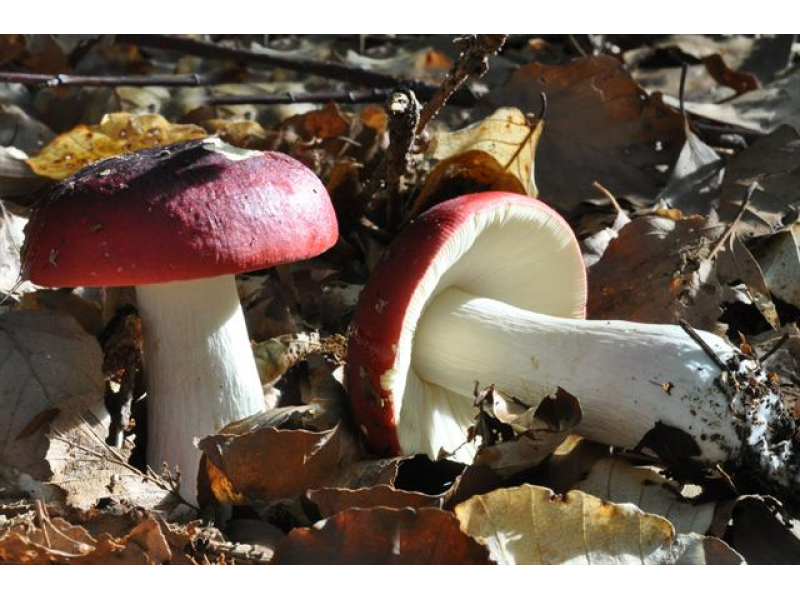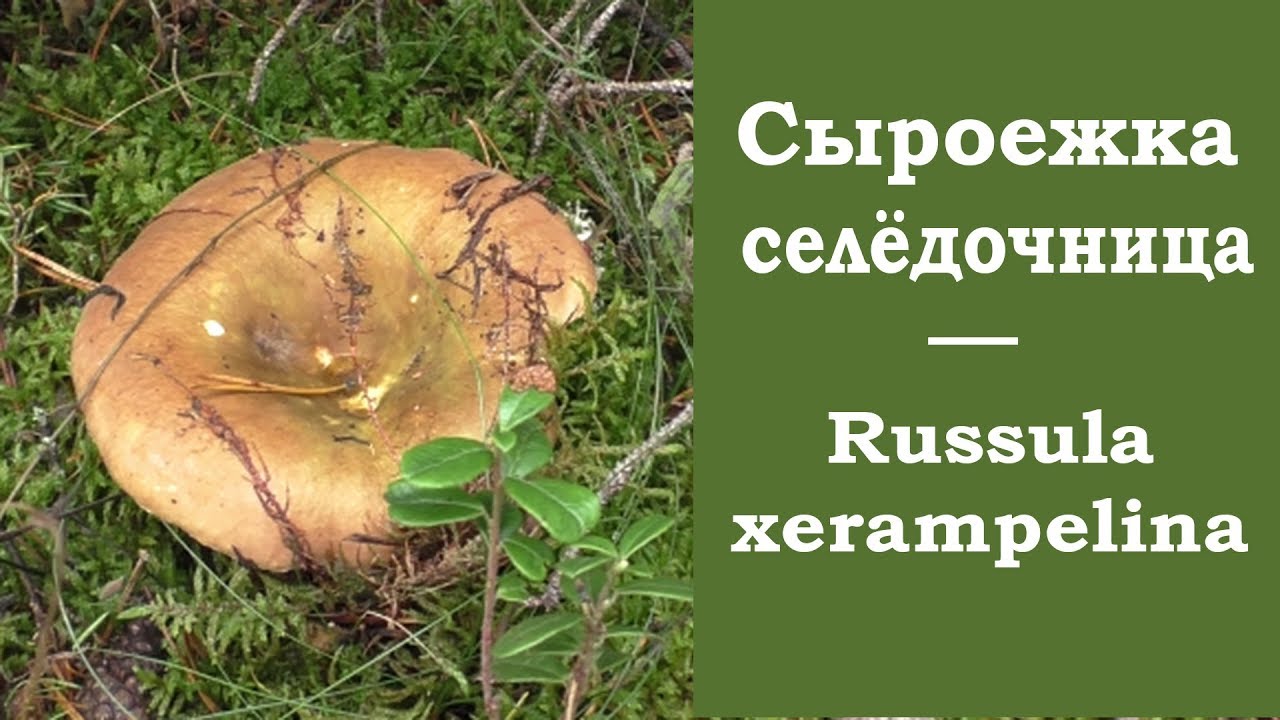Description
The cap reaches 3.5-10.5 cm in diameter, first convex, then flattened, depressed and funnel-shaped. The color at the edge is violet-red, in the center it is violet-black, sometimes with brownish spots. The skin is dull, sometimes velvety in dry weather.
adherent to the stem, cream or light buffy.
The stem is cylindrical or clavate, with a carmine-red tint, turning brown when damaged.
The pulp is strong, white, turning brown or yellowing in the air. The smell of fresh mushrooms is rather weak, when dry it becomes strong, shrimp.
Spore powder of ocher or light yellow color. Spores 8.5-10.5 × 6.5-8 µm, elliptical, spinous, with a fairly well-developed mesh. Pileocystids are generally cylindrical, less often clavate or fusiform.
Edible, has a pleasant, non-bitter taste, but a strong specific odor.
Similar species
Brown russula is included in the complex of species with a shrimp smell, differing only in microscopic structure and ecology.
- Russula abietum (J. Blum) Bon, 1983 grows under the fir.
- Russula amoenipes (Romagn.ex Bon) Bidaud, Moënne-Locc. & Reumaux, 1996 grows under a pine tree, characterized by small spores with a well-developed mesh.
- Russula cicatricata Romagn. ex Bon, 1987 known from Greenland, grows under deciduous trees, has a greenish cap.
- Russula clavipes Velen., 1920 grows under a spruce, in mountain forests - a birch floor, usually distinguished by a greenish cap.
- Russula cretata Romagn. ex Reumaux, 1996 is a very rare species that grows under oak and beech.
- Russula faginea Romagn. ex Adamčík, 2003 grows only under beech.
- Russula favrei M.M. Moser, 1978 grows in mountain coniferous forests, the cap is mostly dark brown, the smell is very weak.
- Russula graveolens Romell, 1893 grows in deciduous forests of Europe, the color of the cap is very diverse.
- Russula langei Bon, 1970 is very rare in deciduous forests, the cap is purple, then green, the stem with a purple tint.
- Russula oreina Singer, 1938 known from Altai, is distinguished by large spores.
- Russula pascua (F.H. Møller & Jul.Schäff.) Kühner, 1975 grows under willow and birch in mountain forests, red-brown hat.
- Russula pseudoolivascens Kärcher, 2002 grows under deciduous trees, has a greenish cap.
- Russula subrubens (J.E. Lange) Bon, 1975 grows only under willow.
Evaluation of the taste of aromatic russula
Brown russula is distinguished by its high taste. In some countries, these mushrooms are even considered delicious. Fragrant russula can be boiled, fried, pickled and consumed in a salted form.
Other mushrooms of this genus
Russula whole or flawless, or wonderful, or brown-red - edible mushroom. The shape of its cap is at first hemispherical, then prostrate, while the center is depressed. The diameter of the cap is 4-12 centimeters. The color of the cap is blood red, and the center is brownish or olive yellow. The cap is dense, slimy. The leg is white or with a slight pinkish bloom, there are yellow spots at the base.
Russula grow in whole groups, on calcareous soils, in coniferous forests. They bear fruit from July to October. In terms of taste, these edible mushrooms are classified in the 3rd category.

Almond russula or cherry laurel russula is an edible mushroom. The hat is medium in size. Its color is changeable, at first it is ocher-yellow, and over time it becomes parietal - honey-brown. The leg is brown in the lower part, and light in the upper part. The pulp is hot on the palate with a characteristic almond aroma.
Almond russules bear fruit from summer to autumn. They grow in mixed and deciduous forests, rarely found in conifers. Most often, these mushrooms are found singly.
Rusula golden-red - edible mushroom. At a young age, his hat is bell-shaped, over time it becomes flat and even slightly depressed. The skin separates well from the pulp. The color of the cap is brick, yellow, red with a purple tint.
The stem is dense with numerous scales. The color of the leg is creamy, and turns brown by old age. Russula grows golden-red in deciduous forests. But they are very rare, and only in small groups.

Russula golden - description, where it grows, the toxicity of the mushroom
It is worth noting an interesting fact that the fruit bodies in question are one of the most popular mushrooms. Russula are common all over the world. In addition, such specimens are very easy to assemble. Due to the bright and memorable color, such fruits can be found without problems in wooded areas. Almost all representatives of this species have a pleasant taste and aroma. Therefore, they are highly valued in the culinary world.
Description
- Fruiting bodies may have a cap no more than 12 cm in diameter. If we take into account young specimens, then they have a convex shape. Only over time does the cap become open. You can often see a depression in the center. The edges become ribbed.
- The surface of young fruiting bodies is glossy and smooth. You may also notice that it is covered in mucus. The color of the cap is almost always brick red. Older fruits have a matte and velvety surface. Their color is often ocher-yellow or orange with reddish spots.
- As for the general structure of the fruiting body, the pulp is crumbly and brittle. In most cases, it has a whitish tint. At the same time, after cutting the mushrooms, the color does not change in any way. Under the cap there are frequent plates that fit tightly to the leg. They are rounded to the edges of the cap.
Spreading
- The fruit bodies in question often grow in forests with old oaks, beech, hazelnuts, spruces and aspens. Linden, elm and similar broadleaf trees can also be found in such woodlands.
- In most cases, such specimens prefer to choose calcareous soil. The fruiting season is mid-summer. It ends in the middle of autumn. Instances can be found singly or in small groups.
Virulence
Mushrooms are edible. However, such specimens, in comparison with relatives, cannot boast of high taste and a bright rich mushroom aroma. This applies to raw fruits. When cooked, mushrooms acquire a completely different, rather good taste and aroma.
Similar species
- The morse russula is similar to the fruit bodies under discussion. Such an instance belongs to edible mushrooms. The hat of such a russula in diameter can reach up to 12 cm. Separately, it is worth noting the fact that in young fruiting bodies, the cap looks like a ball.
- Over time, it takes on the shape of a bell. Old fruiting bodies can already be seen with a flat cap. There is also an old skin on it, while it separates from the pulp without any problems. The hat is often yellow-brown. The leg has a dense structure and a white color. It is rare to see spots on it.
- In most cases, the legs of such mushrooms are almost even, only sometimes they thicken closer to the ground. These russula can often be found in Russian forests. It is this type of fruiting bodies that account for about 48% of all other fruits.
- In most cases, mushrooms are salted. The problem is that they taste rather bitter. Therefore, before salting, they must be soaked and get rid of the skin from the cap.
- There is also another species that is similar to our mushrooms. The fragile russula is considered a conditionally edible fruiting body. It is small in size. The diameter of its cap can be up to a maximum of 6 cm. Most often it is painted in a pinkish-purple hue. In young specimens, the cap is initially convex.
Golden russules are quite common all over the world. As for the collection of such fruiting bodies, then you should not have any problems with this. The distribution of these copies is quite extensive. After cooking, the mushrooms acquire excellent taste and pleasant aroma.

